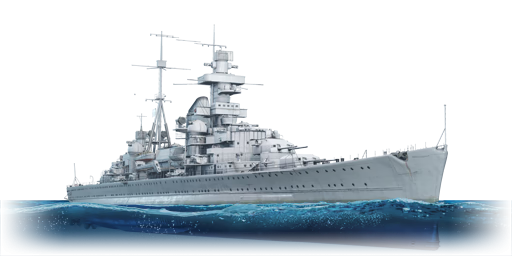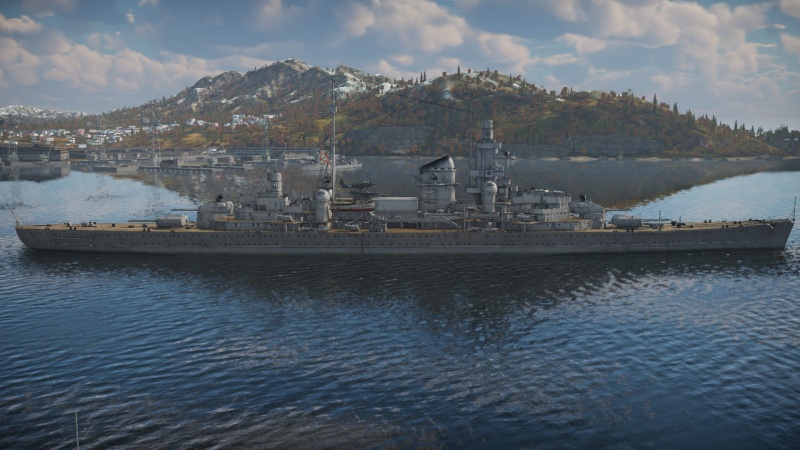Difference between revisions of "Admiral Hipper"
R_nminbiY_n (talk | contribs) (template) |
(→Additional armament: added scout plane) |
||
| Line 52: | Line 52: | ||
''Describe the available additional armaments of the ship: depth charges, mines, torpedoes. Talk about their positions, available ammunition and launch features such as dead zones of torpedoes. If there is no additional armament, remove this section.'' | ''Describe the available additional armaments of the ship: depth charges, mines, torpedoes. Talk about their positions, available ammunition and launch features such as dead zones of torpedoes. If there is no additional armament, remove this section.'' | ||
| + | === Scout plane === | ||
| + | {{main|Ar 196 A-3}} | ||
| + | |||
| + | Midships is a single catapult for an [[Ar 196 A-3|Ar 196]] seaplane. This provides useful abilities for the ship, especially ability to project her control radius. The Ar 196 can cap the zone, lay down cover smoke (3 times), attack enemy targets both sea and air, and even carries 2 x 50 kg bombs. Although this is the same Ar 196 as the Premium event aircraft, certain abilities are not available like choosing offensive weapons load or in-cockpit view. Captains will be wise to remember this ability and consider when best to use, for example early or late in match to cap a point, use smoke screen to thwart enemy attacks, or attack enemy units instead, or perhaps some original action. | ||
== Usage in battles == | == Usage in battles == | ||
Revision as of 06:14, 18 December 2021
| This page is about the German heavy cruiser Admiral Hipper. For the other Admiral Hipper-class cruiser, see Prinz Eugen. |
Contents
Description
The Admiral Hipper-class, Admiral Hipper, 1942 is a rank IV German heavy cruiser with a battle rating of 5.7 (AB/RB/SB). It was introduced in Update 1.91 "Night Vision".
General info
Survivability and armour
Talk about the vehicle's armour. Note the most well-defended and most vulnerable zones, e.g. the ammo magazine. Evaluate the composition of components and assemblies responsible for movement and manoeuvrability. Evaluate the survivability of the primary and secondary armaments separately. Don't forget to mention the size of the crew, which plays an important role in fleet mechanics. Save tips on preserving survivability for the "Usage in battles" section. If necessary, use a graphical template to show the most well-protected or most vulnerable points in the armour.
Mobility
Write about the ship's mobility. Evaluate its power and manoeuvrability, rudder rerouting speed, stopping speed at full tilt, with its maximum forward and reverse speed.
| Mobility Characteristics | |||
|---|---|---|---|
| Game Mode | Upgrade Status | Maximum Speed (km/h) | |
| Forward | Reverse | ||
| AB | |||
| Upgraded | 70 | 25 | |
| RB/SB | |||
| Upgraded | 60 | 22 | |
Modifications and economy
Armament
Primary armament
Provide information about the characteristics of the primary armament. Evaluate their efficacy in battle based on their reload speed, ballistics and the capacity of their shells. Add a link to the main article about the weapon: {{main|Weapon name (calibre)}}. Broadly describe the ammunition available for the primary armament, and provide recommendations on how to use it and which ammunition to choose.
Secondary armament
Some ships are fitted with weapons of various calibres. Secondary armaments are defined as weapons chosen with the control Select secondary weapon. Evaluate the secondary armaments and give advice on how to use them. Describe the ammunition available for the secondary armament. Provide recommendations on how to use them and which ammunition to choose. Remember that any anti-air armament, even heavy calibre weapons, belong in the next section. If there is no secondary armament, remove this section.
Anti-aircraft armament
An important part of the ship's armament responsible for air defence. Anti-aircraft armament is defined by the weapon chosen with the control Select anti-aircraft weapons. Talk about the ship's anti-air cannons and machine guns, the number of guns and their positions, their effective range, and about their overall effectiveness – including against surface targets. If there are no anti-aircraft armaments, remove this section.
Additional armament
Describe the available additional armaments of the ship: depth charges, mines, torpedoes. Talk about their positions, available ammunition and launch features such as dead zones of torpedoes. If there is no additional armament, remove this section.
Scout plane
Midships is a single catapult for an Ar 196 seaplane. This provides useful abilities for the ship, especially ability to project her control radius. The Ar 196 can cap the zone, lay down cover smoke (3 times), attack enemy targets both sea and air, and even carries 2 x 50 kg bombs. Although this is the same Ar 196 as the Premium event aircraft, certain abilities are not available like choosing offensive weapons load or in-cockpit view. Captains will be wise to remember this ability and consider when best to use, for example early or late in match to cap a point, use smoke screen to thwart enemy attacks, or attack enemy units instead, or perhaps some original action.
Usage in battles
The Admiral Hipper is an immensely powerful heavy cruiser which shows very few signs of weakness. Like the other German cruisers, it's exceptionally strong, with great anti-torpedo protection and turtleback armour, giving it fantastic waterline armour. This, combined with a huge crew count, means the Hipper needs to take a huge amount of punishment to be sank. The Hipper's main armament - eight 8-inch guns in dual turrets - is also very effective, with a 12 second reload and fantastic armour penetration and muzzle velocity (enough in some cases to penetrate even battleship armour). It also boasts a strong secondary armament, a phenomenal anti-aircraft suite at both close and long range, and good torpedoes. The Hipper should be played as a long range brawler, able to dish it out and take damage from other heavy cruisers, while also combatting enemy aircraft with ease.
The main weakness for the Hipper comes from its status - everyone knows how dangerous it is. Most skilled players will know to target this ship first, and while the armour is good, it isn't enough to save it from other eight-inch guns at close range, or battleship guns at any range. Stay on the move, use cover, and keep an eye out for anything with guns bigger than yours, and you should stay alive. In the meantime, use your accurate guns to punish other cruisers from long range, and even battleships if you can flank them.
Pros and cons
Pros:
- Phenomenal firepower from the main battery that can punish any cruiser at long range and even battleships that get too close
- Fantastic AA suite which can decimate aircraft even from long range
- Great armour protection against small calibre guns
- Huge crew size make it tough to sink, especially for light cruisers
- Very mobile despite its size, allows it to reposition with ease
Cons:
- Excessive listing at high speed or on a turn, resulting poor aiming quality. The situation worsens in arcade battle.
- The armour is weak in term of absolute thickness, meaning large calibre guns can overmatch your armour
- Main battery magazines are located above shell rooms, meaning that a detonation is likely to be fatal
History
Following the signing of the Anglo-German Naval Agreement in June 1935, Germany was permitted to build, among other things, heavy cruisers up to a total displacement of 50,000 tons. The previously developed Admiral Hipper-class heavy cruiser design was chosen for construction, with five ships being initially planned to be built.
The five ordered ships of the Admiral Hipper-class were laid down between July 1935 - August 1937. However, only the first three were actually fully constructed and commissioned into service between 1939 - 1940. The fourth ship - Seydlitz - was scuttled in 1945 still being incomplete (as a conversion into an aircraft carrier), while the fifth ship - Lützow - was also sold incomplete to the USSR in February 1940.
Admiral Hipper, named after an imperial German admiral, was the first ship of the class to see completion, being commissioned into service in April 1939. After passing sea trials, Admiral Hipper was assigned to her first combat mission - Operation Weserübung - the invasion of Denmark and Norway, where it took part in a battle with the British destroyer Glowworm and also participated in the sinking of the trawler Juniper (930 tons) and the military transport Orama (19,000 registered tons). Subsequently, Admiral Hipper steamed out into the Atlantic to intercept allied shipping in December 1940, but without significant success. The first campaign wasn't particularly successful, but during the second campaign in January and February of 1941, the Admiral Hipper attacked SLS-64, an unprotected convoy - this attack on ship count alone, was the most effective from both world wars.
Admiral Hipper was then transferred to Norway, where it took part in raids against the arctic convoys headed for the Soviet Union. As part of an operational group, it took part in Operation Rösselsprung (Knight's move) which, although not a success, resulted in the almost total destruction of the allied PQ-17 convoy by German submarines and aircraft. In December of 1942, during Operation Regenbogen (Rainbow) a battle took place in the Barents Sea which was unofficially labelled as "New Year's Battle" or "New Year's Shame" the ship was damaged and sent back to Germany for repair. The failure of the operation led to a historical decision by Hitler to order the scrapping of all large warships. Admiral Hipper was transferred to the reserves and at the beginning of 1945, arrived in Kiel where it was damaged during allied air strikes in May of the same year. The defenders on the partially disarmed ship showed no enthusiasm for its survival and as a result, the ship burned out and sank to the dock seabed. After the war, the ship was once again raised and taken apart for scrap up to 1952.
- From Devblog
Media
- Skins
- Videos
See also
Links to articles on the War Thunder Wiki that you think will be useful for the reader, for example:
- reference to the series of the ship;
- links to approximate analogues of other nations and research trees.
External links
| Blohm & Voss | |
|---|---|
| Destroyers | |
| Type 1934A | Z15 Erich Steinbrinck |
| Heavy Cruisers | |
| Admiral Hipper-class | Admiral Hipper |
| Battlecruisers | |
| Unique Ships | SMS Von der Tann · SMS Derfflinger |
| See Also | Blohm & Voss Aircraft Division |
| Germany heavy cruisers | |
|---|---|
| Admiral Hipper-class | Admiral Hipper · Prinz Eugen |
| Deutschland-class | Admiral Graf Spee |





